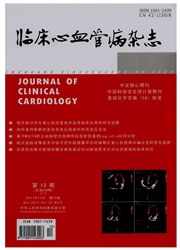

 中文摘要:
中文摘要:
慢性心力衰竭(chronic heart failure,CHF)是大多数心血管疾病的最终归宿,因具有高发病率、高病死率而引起人们的关注。CHF的标志是左心室进行性扩张、左室壁压力的增加,导致心肌耗氧量增加。根据拉普拉斯定律,运用一种组织工程学技术增加室壁厚度、减少心室腔直径,从而减少室壁压力、改善左室功能,本文总结归纳了这种组织工程技术在治疗CHF中的作用机制和Algisyl-LVR相关的试验结果。
 英文摘要:
英文摘要:
Chronic heart failure (CHF) is the end result of various cardiovascular diseases. It has caused much concern because of its high morbidity and mortality. The hallmark of CHF is the progressive dilatation of the left ventricle, thinning of the left ventricular wall leading to increased wall stress and increased myocardial oxygen consumption. Applying Laplace's law,utilizes a tissue engineering strategy to increase wall thickness and reduce chamber volume, resulting in a decrease in wall stress and improved left ventricular function. The present review primarily focuses on the rationale for an tissue engineering approach for this treatment of CHF and experiment re- suits of the Algisyl-LVR program are presented treatment of heart failure.
 同期刊论文项目
同期刊论文项目
 同项目期刊论文
同项目期刊论文
 High mobility box 1 mediates neutrophil recruitment in myocardial ischemia-reperfusion injury throug
High mobility box 1 mediates neutrophil recruitment in myocardial ischemia-reperfusion injury throug The HMGB1-TLR4 axis contributes to myocardial ischemia/reperfusion injury via regulation of cardiomy
The HMGB1-TLR4 axis contributes to myocardial ischemia/reperfusion injury via regulation of cardiomy RP105 Protects Against Apoptosis in Ischemia/Reperfusion- Induced Myocardial Damage in Rats by Suppr
RP105 Protects Against Apoptosis in Ischemia/Reperfusion- Induced Myocardial Damage in Rats by Suppr Radioprotective 105 kDa protein (RP105): is a critical therapeutic target for alleviating ischemia r
Radioprotective 105 kDa protein (RP105): is a critical therapeutic target for alleviating ischemia r Resveratrol pretreatment protects rat hearts from ischemia/reperfusion injury partly via a NALP3 inf
Resveratrol pretreatment protects rat hearts from ischemia/reperfusion injury partly via a NALP3 inf RP105 protects against myocardial ischemia-reperfusion injury via suppressing TLR4 signaling pathway
RP105 protects against myocardial ischemia-reperfusion injury via suppressing TLR4 signaling pathway MicroRNA-22 targeting CBP protects against myocardial ischemia-reperfusion injury through anti-apopt
MicroRNA-22 targeting CBP protects against myocardial ischemia-reperfusion injury through anti-apopt Increased expression of RP105 decreases cardiomyocytes hypoxia/reoxygenation injury through the TLR4
Increased expression of RP105 decreases cardiomyocytes hypoxia/reoxygenation injury through the TLR4 A Meta-Analysis of Randomized Clinical Trials Comparing Shorter (Less or Equal Than 6 Months) and Lo
A Meta-Analysis of Randomized Clinical Trials Comparing Shorter (Less or Equal Than 6 Months) and Lo Effect of virtual reality distraction on pain among patients with hand injury undergoing dressing ch
Effect of virtual reality distraction on pain among patients with hand injury undergoing dressing ch 期刊信息
期刊信息
